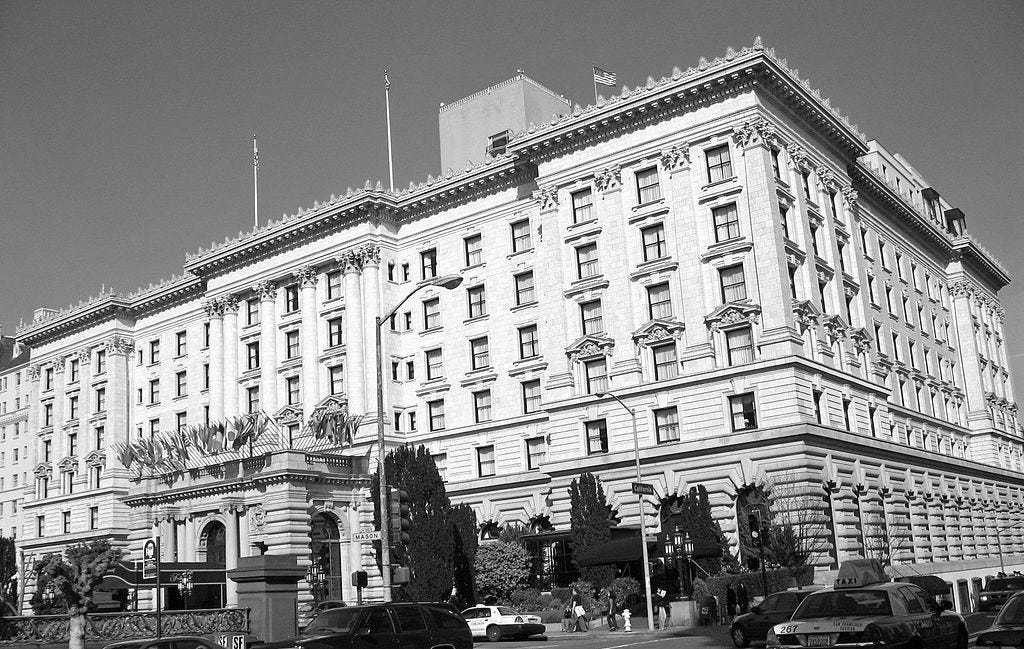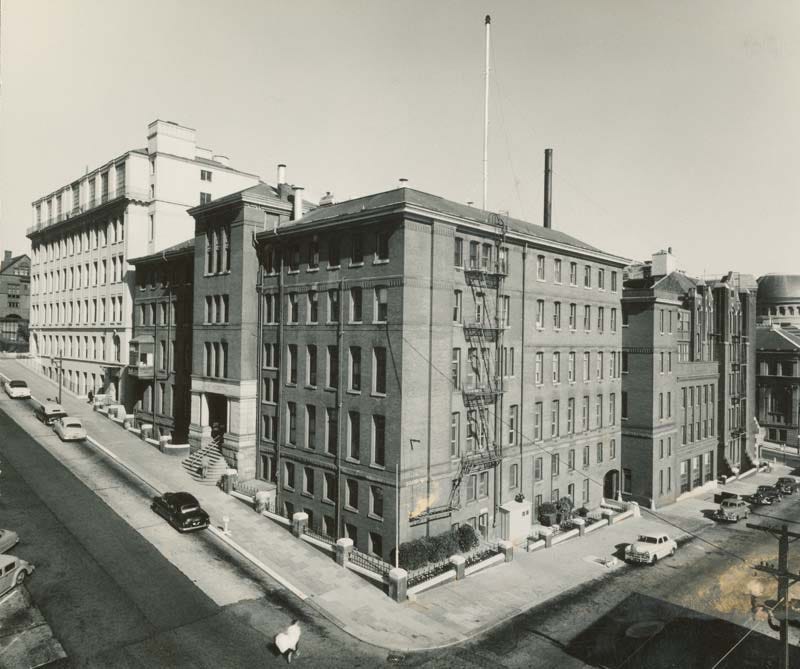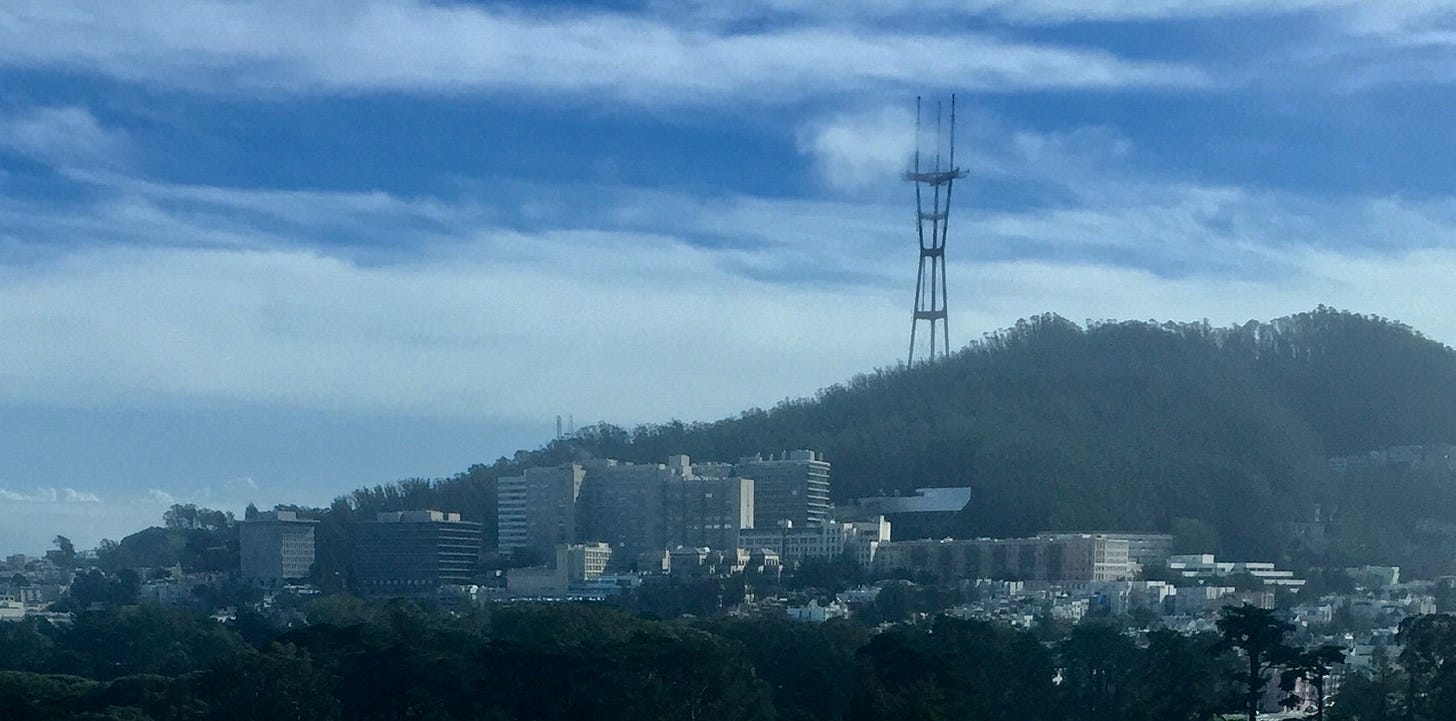2. New Foundations
In 1938, Los Angeles was the fifth most populous city in the United States; San Francisco was the twelfth. Nevertheless, in its ninety-three years of existence, the American Psychiatric Association had never held an annual meeting on the West Coast, and no West Coast psychiatrist had ever been president of the A.P.A. The closest the annual meeting had come to California had been Denver, Colorado, in 1895 and 1911, and San Antonio, Texas, in 1905. Commercial air travel was still expensive and uncommon; it took five days, with a transfer of depots in Chicago, to travel by train from New York to San Francisco.
This second installment of Reason’s Frontier: Psychiatric Science and Therapeutic Culture in Twentieth-century San Francisco begins in 1938 with the A.P.A.’s decision to hold its annual meeting in northern California. The president of the A.P.A., Ross McClure Chapman, explained: "as an association our interests do not stop at the Appalachians . . . [they] are becoming truly American.” As the superintendent of Baltimore’s Sheppard and Enoch Pratt Hospital, Chapman was part of the East Coast establishment that had long dominated the profession. Even so, he recognized the need for psychiatry to develop “a continental consciousness.” According to the editors of the American Journal of Psychiatry, the time had come “for East and West to draw nearer together for mutual advantage.”1

On Monday, June 6, 1938, the A.P.A. convened its ninety-fourth annual meeting at San Francisco’s Fairmont Hotel. On the same day, Sigmund Freud, now in his 80s, arrived in London after fleeing from Nazified Austria.2
Piggybacking on the annual meeting, the American Psychoanalytic Association (APsaA) arranged to hold a concurrent session in San Francisco— the first event of its kind on the West Coast. Freud’s arrival to safety in London heightened curiosity about the local proceedings. Among the dignitaries who converged on the Fairmont were Franz Alexander, then president of the APsaA and the director of the Chicago Institute for Psychoanalysis; Freud’s distinguished translator, A.A. Brill; and Adolf Meyer, the director of the Henry Phipps Psychiatric Clinic at Johns Hopkins. San Francisco’s first-to-arrive refugee analysts, Bernhard Berliner and Siegfried Bernfeld, were among those scheduled to speak.3
The decision to convene in California signaled the A.P.A.’s desire to engage a segment of the membership normally absent from annual meetings. Of its nearly 2,000 members, just under 300 would travel to the San Francisco meeting.4 But the A.P.A.’s conscious effort to include members west of the Mississippi was an acknowledgment that its organizational strength depended on nationwide solidarity and the successful integration of the West. The days were over when a handful of asylum superintendents from prestigious East Coast institutions could speak for the profession as a whole. In California, institution-building—laying the foundations for modern psychiatric care—was the watchword of the day.

In the years leading up to U.S. entry into World War II, there were fewer than 80 medical schools in the entire United States.5 San Francisco was home to two of them: Stanford and the University of California. Historically, psychiatry had languished on the margins of the medical curriculum. (Asylum psychiatrists developed their skills mainly through on-the-job experience.) At the Stanford School of Medicine, neuropsychiatry was part of the Department of Medicine. Out of 4,000 hours of instruction, medical students at Stanford received 157 hours of neuropsychiatric training.6 While most general hospitals did not assign beds to patients with psychiatric symptoms, Stanford was an exception. For years, the only private neuropsychiatric ward accepting psychiatric patients was at Stanford Lane Hospital.
Similarly, at the University of California, neurology and psychiatry were organized under the Division of Medicine. Compared to Stanford, however, UC allocated even fewer hours of instruction to those fields. To train medical students and residents, programs needed access to patients on psychiatric wards. However, the University of California Hospital as a rule would transfer patients with psychiatric symptoms as soon as possible to the state hospital system. Knowing that the field of psychiatry was changing, UC administrators were eager to modernize their training program. If the medical school hoped to train residents, UC would need greater access to inpatients (“clinical material”) for teaching purposes.7
When Harry Lutgens, the director of the California Department of Institutions, proposed to build a modern neuropsychiatric hospital in San Francisco, UC president Robert Gordon Sproul quickly identified a suitable site. Robert Langley Porter, the medical school dean, was eager to bring a scientific research institute to the medical campus— something similar to the Boston Psychopathic Hospital or the Illinois Neuropsychiatric Institute. The Lutgens plan acquired momentum when California elected Culbert L. Olson, a New Deal Democrat, as governor in 1938. On Governor Olson’s request, the California Legislature approved $500,000 for construction of the proposed 100-bed hospital, and the University deeded a site on San Francisco’s foggy, wind-swept Parnassus Heights.

One of Governor Olson’s first decisions was to appoint Aaron J. Rosanoff to head the California Department of Institutions. Rosanoff was not only a well-regarded psychiatrist; he was the first psychiatrist ever appointed to direct the Department of Institutions. As an evangelist for extramural care, Rosanoff envisioned a rationally organized continuum of psychiatric services. Under his direction, the Department of Institutions began issuing licenses to nursing homes, sanitariums, and other private facilities to provide care for mentally ill patients. Few of his proposals were new. “What is new,” he told an audience at Stockton State Hospital, “is the proposition to organize their operation in the State of California in a fully comprehensive manner.” By treating acute illnesses in the city, Rosanoff hoped to restrict the flow of patients to state hospitals, which had become, in his words, “physically and mentally unhygienic, esthetically revolting, and altogether intolerable.”8
It was decided that the director of the new hospital should occupy a dual position— as hospital superintendent on the state’s payroll and as chair of a new department of psychiatry on the University’s payroll.9 Rosanoff, Sproul, and Langley Porter knew it was important to get the right person. They needed an experienced administrator who could arbitrate interagency disputes, a confidence-inspiring institution builder with academic credentials and unimpeachable integrity.
They found that person in Karl M. Bowman. A native of Topeka, Kansas, Bowman held dual appointments as a hospital administrator and as a faculty member in New York City: he was a professor of psychiatry at New York University and the director of hospital psychiatry for the city. In the latter role, he ran the psychiatric division at the storied Bellevue Hospital, the Kings County psychiatric pavilion in Brooklyn, five mental hygiene clinics, and a court clinic.10
Bowman and Rosanoff already knew each other and had a good rapport. The plain-speaking, pragmatic Bowman— a one-time Washburn College quarterback and U.S. Army psychiatrist, with his “flat Kansas voice” and “slightly pigeon-toed gait”— was hard-working, tenacious, and completely unpretentious. On a visit to New York, Sproul had met with Bowman to get his candid opinion on a list of candidates for the California job. One year later, Bowman got word that Sproul and Rosanoff wanted to hire him.11
On April 5, 1941, officials from the University of California and the Department of Institutions laid the cornerstone of the new Langley Porter Clinic, named after the emeritus medical school dean. For Governor Olson, the Langley Porter Clinic exemplified the bold experimentation and ethical vision of Franklin Roosevelt’s New Deal. Robert Sproul invoked the names of past reformers—Phillippe Pinel, who “unshackled” the asylum inmates in Paris; Dorothea Dix, who wrote about the mistreatment of the “insane poor” of New England— and pledged to deliver both state-of-the-art care to patients and economies for the state’s taxpayers.12 The Langley Porter Clinic epitomized the longer interwar trend toward extramural care. Moreover, the pursuit of scientific knowledge offered hope that the problem of asylum overcrowding might be solved.
What Karl Bowman was to institution building at the University of California, Jacob Kasanin was to the expansion of psychiatry at Mount Zion Hospital. In 1939, Mount Zion appointed the Russian-born Kasanin, a psychoanalyst and schizophrenia researcher at Chicago’s Michael Reese Hospital, to head Mount Zion’s newly renovated department of psychiatry. The Jewish Family Service Agency had purchased a “warm, homey” cottage on Scott St. to house an expanded outpatient service. Under Kasanin’s leadership, psychoanalytic techniques would soon become the cornerstone of patient care; a major focus of the clinic was “to perfect more effective methods of therapy of the various neuroses.”13

In San Francisco, a small circle of psychoanalysts and others interested in the Freudian method had begun convening for “technical seminars” in each other’s living rooms. The group consisted of physician psychoanalysts, such as Bernhard Berliner, but also nonphysician analysts, such as Siegfried Bernfeld—one of Freud’s star pupils. The most famous nonphysician analyst to join the San Francisco circle was Erik H. Erikson, who would go on to become one of the century’s most influential thinkers. (Erikson, too, was a refugee analyst. His mother was from a prominent Jewish family in Copenhagen; although his father was a Dane, his stepfather was a German Jew.) The Lithuanian-born analyst Anna Maenchen, a nonphysician trained by Anna Freud, later recalled: “We led a kind of Viennese coffee-house existence.”14
Only days after the news of Freud’s death came in 1939, the San Francisco analysts agreed to form an official psychoanalytic society affiliated with the American Psychoanalytic Association. The previous year, however, the national organization had decided that only qualified physicians would be admitted as training candidates at U.S. psychoanalytic institutes. This rankled the nonphysician analysts from Europe, some of whom had trained directly with Freud or with his daughter Anna.15
The exclusion of nonphysicians from psychoanalytic training in the U.S. called attention to a more profound disagreement over the relationship between psychoanalysis and the medical profession. On one side were those who considered psychoanalysis to be an independent science, distinct from and irreducible to medical psychotherapy. For them, psychoanalysis was its own Wissenschaft, a scientific psychology offering a general theory of mind and unique research methods. Advocates of this view feared that psychoanalysis would be swallowed up, domesticated, or intellectually compromised by its association with psychiatry. They frequently cited Freud’s 1926 vision of an independent “college of psycho-analysis.”16
On the other side of the debate were the analysts who welcomed an alliance between psychiatry and psychoanalysis. Such an alliance would help to legitimize psychoanalysis in the United States while adding an impressive new weapon— psychoanalytic psychotherapy—to the psychiatrist’s otherwise limited arsenal. This faction quickly gained the upper hand in San Francisco. Under Jacob Kasanin’s direction, psychoanalytic psychotherapy found a home at the Mount Zion Psychiatric Clinic— the first stronghold of psychoanalytic psychiatry anywhere on the West Coast. Under the tutelage of the refugee analysts, psychiatrists adopted psychoanalytic psychotherapy as the treatment of choice for neurotic symptoms.
Psychoanalysis offered to psychiatry a general theory of mind, a useful therapeutic technique, and an innovative set of research methods. Originally regarded as a bohemian movement on the fringe of medicine, psychoanalysis became the dominant paradigm guiding the development of psychiatry in the United States. Even before U.S. entry into World War II, medically administered psychotherapy introduced psychoanalytic ideas and psychotherapeutic practice into the public culture of the San Francisco Bay Area.
When the American Psychiatric Association convened its annual meeting in San Francisco in 1938, it called attention to the contributions of its West Coast members. It also highlighted the need for better training facilities, easier access to outpatient treatment, and stronger professional organizations on the West Coast. Psychiatry’s legitimacy as a medical specialty depended on its organizational power and scientific credibility. The establishment of a scientific research institute in San Francisco, along with outpatient clinics, urban psychiatric wards, and independent departments of psychiatry, was a giant step in that direction.
A note on sources: Complete citations can be found in Justin Suran, "Toward an Illusionless City: The Province of Psychiatry in Twentieth-century San Francisco" (Ph.D. diss., Univ. of California, Berkeley, 2003).
Ross McClure Chapman, “Presidential Address,” American Journal of Psychiatry 95, no. 1 (July 1938): 1; “The San Francisco Meeting,” American Journal of Psychiatry 95, no. 1 (July 1938): 227.
“Freud in Exile,” American Journal of Psychiatry 95, no. 1 (July 1938): 228-29; Peter Gay, Freud: A Life for Our Time (New York: W.W. Norton & Co., 1988), 626-29.
American Psychoanalytic Association Bulletin I (1937/38).
The A.P.A. had never published a nationwide membership directory. “The San Francisco Meeting,” 227.
Lynn E. Miller and Richard M. Weiss, “Medical Education Reform Efforts and Failures of U.S. Medical Schools, 1870–1930,” Journal of the History of Medicine and Allied Sciences 63, no. 3 (2008): 348–87, http://www.jstor.org/stable/24631864.
Annual Announcements of the School of Medicine, Stanford University Bulletin, 1934-1935 & 1940-1941, Lane Medical Library; Announcements of the Univ. of California School of Medicine, 1934-1935 & 1940-1941, UCSF Archives.
Jurgen Ruesch, The Langley Porter Institute and Psychiatry in Northern California, 1943-1975 (San Francisco: Friends of Langley Porter Institute, 1978), 14-21.
Organized psychiatry applauded Olson’s choice as a triumph of “scientific psychiatry” over politics. “Psychiatric Progress in California,” American Journal of Psychiatry 95, no. 4 (Jan. 1939): 984-85; Aaron J. Rosanoff, “California State Hospitals: The Problem of Overcrowding,” California and Western Medicine 50, no. 2 (Feb. 1939): 109-111.
Mariana Robinson, The Coming of Age of the Langley Porter Clinic: The Reorganization of a Mental Health Institute (published for the ICP by Univ. of Alabama Press, 1962).
Bowman had been the chief medical officer at the Boston Psychopathic Hospital and an instructor at the Harvard Medical School. He was at Boston Psychopathic when the Italian shoemaker and self-proclaimed anarchist Nicola Sacco was sent for evaluation. At the request of Clarence Darrow, Bowman traveled to Chicago to examine Leopold and Loeb. David W. Allen, “Karl Bowman and the Beginning of Langley Porter,” Connections [UCSF Department of Psychiatry newsletter] (Nov. 1995): 3; Karl M. Bowman, “My Years in Psychiatry, 1915-1968,” interview by Alden B. Mills, 27 & 28 Feb. 1968, Bancroft Library.
Bowman, “My Years in Psychiatry, 1915-1968”; Karl M. Bowman, “Langley Porter Clinic: Establishment and Early Years,” in Tales and Traditions, vol. 4, ed. William E. Carter, UCSF Archives.
“Addresses Delivered on the Occasion of the Laying of the Cornerstone Ceremonies,” 5 April 1941, CU-5, series 2, UCOP Special Project Files, Bancroft Library.
Norman Reider, interview by Barbara Rogers, 6 Feb. 1979, Oral History Project, Mount Zion Hospital Collection; Minutes of the Mount Zion Hospital Board of Directors, 10 Nov. 1938, 9 Apr. 1939 & 29 June 1939, Mount Zion Hospital Collection; “News & Notes,” American Journal of Psychiatry 96, no. 2 (Sept. 1939): 500.
Donald A. MacFarlane, the group’s first training candidate, joined the technical seminar in 1939. Siegfried Bernfeld to Karl Menninger, 24 Oct. 1940, Siegfried Bernfeld Papers, San Francisco Psychoanalytic Institute; Bernhard Berliner, “My Emigration to the United States and the Beginnings of Psychoanalysis in San Francisco,” 3 March 1975, Bernhard Berliner Papers, San Francisco Psychoanalytic Institute; Anna Maenchen, comments on the history of the San Francisco Psychoanalytic Society, 10 June 1957, History of Psychoanalysis in San Francisco File, San Francisco Psychoanalytic Institute; Minutes of the San Francisco Psychoanalytic Group, 26 Sept. 1939, Siegfried Bernfeld Papers, San Francisco Psychoanalytic Institute.
For a thorough consideration of the lay-analyst question, see Robert S. Wallerstein, Lay Analysis: Life Inside the Controversy (Hillsdale, NJ: The Analytic Press, 1998).
Siegfried Bernfeld, “Comments on Dr. Simmel’s Memorandum,” n.d., Siegfried Bernfeld Papers, San Francisco Psychoanalytic Institute; Otto Fenichel to Siegfried Bernfeld, 9 Oct. 1940, Siegfried Bernfeld Papers, San Francisco Psychoanalytic Institute.




